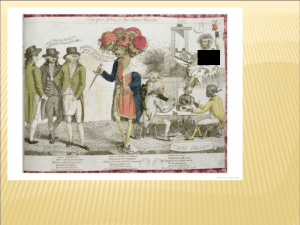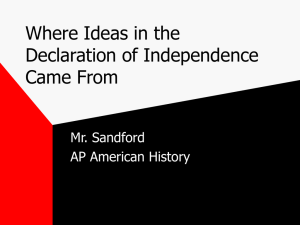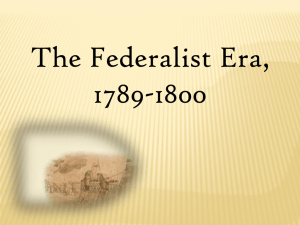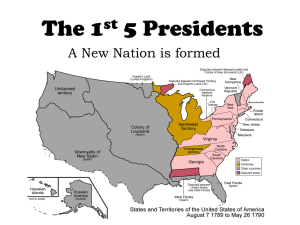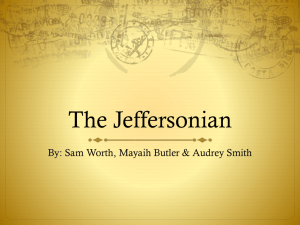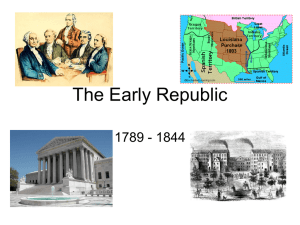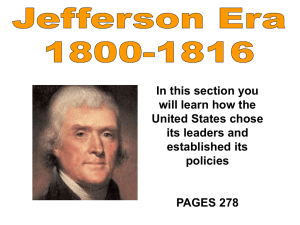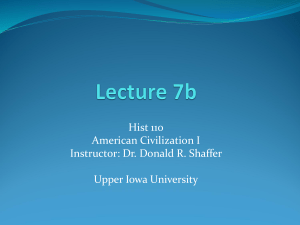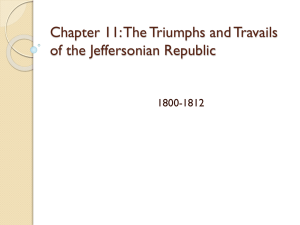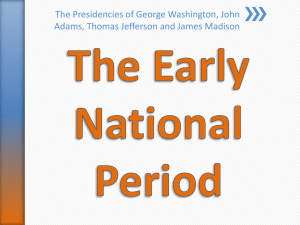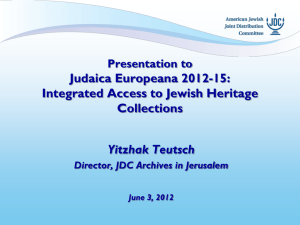1130_2011_Promoting_IR_Slides
advertisement
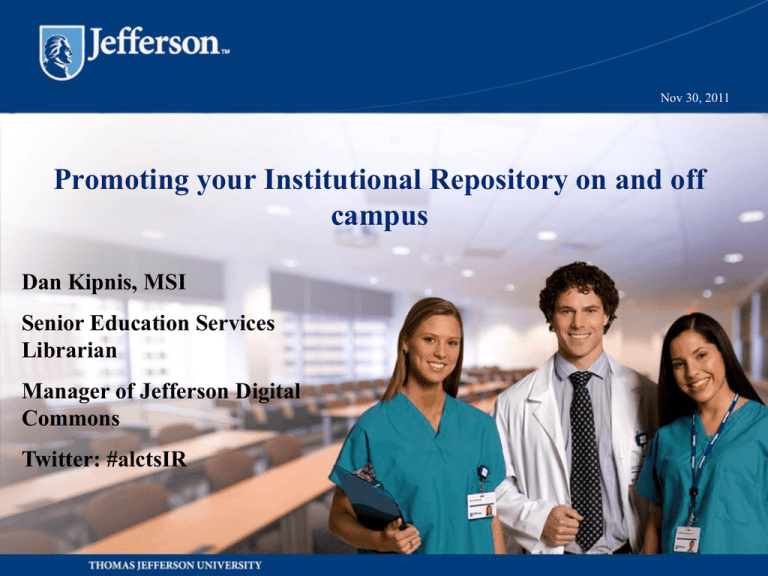
Nov 30, 2011 Promoting your Institutional Repository on and off campus Dan Kipnis, MSI Senior Education Services Librarian Manager of Jefferson Digital Commons Twitter: #alctsIR Agenda • • • • • • A little background on Jefferson Methods of promotion Elevator speech Workflows Toot your horn Questions Jefferson Background Thomas Jefferson University and Hospitals • Founded in 1824 • One of the largest medical schools in US • 900+ bed teaching facility • Philadelphia PA urban campus • 3,509 students and 5,680 fulltime employees • Medical School enrolls 265 students per year Dorrance H. Hamilton simulation bld. Opened Oct 19, 2007 Degrees offered by Thomas Jefferson University • • • • Medicine Nursing Pharmacy Jefferson School of Health Professions – Occupational Therapy – Physical Therapy – Couple and Family Therapy – Radiologic Sciences – Biosciences Technology • Jefferson School of Population Health (Health Policy) • Jefferson College of Graduate Studies (PhD, Postdoctoral, MS) JDC (http://jdc.jefferson.edu) Service & Solutions Define your goal • • • • • • • What are you after? Develop your message It is about your community-not you Solve a problem Look for need Create a brand Commit yourself and more forward We want to start an IR, but… • We have no staff • We lack technology skill set • We have no time Solutions • • • • Use student workers for scanning and loading Use your technicians and paraprofessional staff (new skills) Outsource technology (servers, design etc.) Many libraries are hiring scholarly communication and data librarians What solutions are you providing? • • • • • • • • Increased exposure to a global audience No ads SEO Monthly statistics Free to users File flexibility, version control, editorial control Stability (permanent URL) University Press (Jefferson Journal of Psychiatry) Methods of Promotion Methods of promotion • Workshops: Take Advantage of the Jefferson Digital Commons for Shameless Self-Promotion Increasing Your Research Impact with the Jefferson Digital Commons • Email outreach (Scopus search to gather faculty citations) • Seek out invitations to speak at departmental staff meetings • Elevator speeches-develop your talking points • Social Media (Facebook, Twitter etc.) • You must offensively advocate • Toot your horn Google News Alerts Facebook and Twitter posts Facebook insights Bitly stats (http://bit.ly/fA0W72+) Facebook articles of interest • Gerolimos, M. (2011, November/December). Academic Libraries on Facebook: An Analysis of Users' Comments. DLib Magazine, 17(11-12). doi:10.1045/november2011gerolimos • Phillips, N. K. (2011). Academic Library Use of Facebook: Building Relationships with Students. Journal of Academic Librarianship, 37(6), p.512–522. doi:10.1016/j.acalib.2011.07.008 http://total-impact.org Metrics in total impact Students managing social media? How to use Social Media to Engage Students Tips for social media from a student • • • • Update frequently Urges interactions Great workflow timeline leading up to event Core concept: Have student engage with other students Blog postshttp://jeffline.jefferson.edu/aisrnews/?p=1639 Reddit-What is new and popular on web Additional methods of promotion • • • • • • • • • • New faculty orientation presentations * Emailed all 840 residents and fellows Outreach to postdocs (presentations and emails) Presentations at faculty retreats Flyers with paychecks Wine and Cheese (food always works) Posters in library and out in high traffic areas Events (Open Access Week-Oct 24-30, 2011) Brochures Articles in campus publications Train your staff! • They will help with outreach and recruitment • Example: Our Medical Media Services department (create posters, videos, etc. on campus) They send me conference posters that they produce for loading into the JDC • Anyone on the front lines can help promote your IR • Teach them your talking points Work with your public affairs/PR office • They send out press releases • Can your links appear in their press release? Some Numbers International Survey of Institutional Digital Repositories 2010 • 56 institutions surveyed from 11 countries (USA, Canada, Australia, Germany, South Africa, India, Turkey etc.) • Published by Primary Research Groups (http://bit.ly/f70juo) • 73% of IRs linked to college website • Only 1.69% had link to iTunes • None had link to YouTube site or channel • Only 8.47% had blog for IR • 39% had brochure • Only 13.56% published an annual report • Primary Research Group, ISBN 1-57440-161-0 Questions from the survey • Who contributes to the repositories and on what terms? • Who uses the repositories? • What do they contain and how fast are they growing, in terms of content and end use? • What measures have repositories used to gain faculty and other researcher participation? • How successful have these methods been? • How has the repository been marketed and cataloged? • What has been the financial impact? • Data is broken out by size and type of institution for easier benchmarking. Elevator Speech Your elevator speech • What you need: – Grabber – Name – Value Proposition – Unique Elements – Call to Action Method from Michaelhschaefer.com Grabber • Consultant: – I keep your company out of Dilbert’s comic strip • Librarian – I am the original search engine – You talk, we listen – I’m your secret weapon to impress your supervisor Value Proposition • Do you solve a problem or need? • Are your benefits unique? Volvo: safety McDonalds: consistency FedEx: On time delivery IRs: Research ubiquity and preservation Unique Elements • Librarians help save time by loading content • Researchers save lives by dispersing research • Help find grant money and collaborators by sharing your research Call to Action • • • • Is there something you are requesting from your listener? What is in it for the listener? Make your elevator speech your own Seek a connection Putting it together (30 seconds to 2 mins) Grabber: Dr X, Let me distribute your research to the world. Name: Hi I’m Dan Kipnis and I manage the Jefferson Digital Commons the digital archive of the University. Value Proposition: Let me archive your published articles, videos, PowerPoints, conference posters in the JDC. Unique elements: Email me your content and I’ll load it for you, provide you with monthly email statistics and make your work findable on the web. Call to action: Let’s get all your research and scholarly works out to a global audience. Here’s my card, email me. More persuasion Incentive? Vanity? Faculty want • • • • Visibility Citations Respect Funding Use statistics for persuasion • Over 30% of surveyed faculty in the United States now use a “general-purpose search engine” as the starting point for their research. Over 70% of faculty responded that they use Google or Google Scholar often or occasionally to find information in academic journals. The Jefferson Digital Commons will index your scholarship increasing visibility to a global community that relies on Google, Google Scholar and other search engines for their research. Read the full report by Roger C. Schonfeld and Ross Housewright at: http://www.ithaka.org/ithaka-s-r/ research/faculty-surveys-20002009/ Where do you start your search for information? • 87% google, 10% other search engines, 3% wikipedia • 0% library portals Source: http://www.davidleeking.com/2011/03/31/no-onestarts-at-your-website/ King references: OCLC Perceptions of Libraries, 2010: Context and Community Increased citation rates = tenure • Relative increase of citation rate for open access vs. toll articles has been measured:* – Biology 49% – Political science 86% – Electrical & electronic engineering 51% – Clinical medicine 193% – Mathematics 91% *Data from: Antelman, Kristen. Do Open-Access Articles Have a Greater Research Impact? College and Research Libraries, 65(5), 372-382. September 2004. http://eprints.rclis.org/bitstream/10760/5463/1/do_open_access_CRL.pdf Citation Advantage of Open Access Articles Eysenbach G PLoS Biology Vol. 4, No. 5, e157, May 2006 doi:10.1371/journal.pbio.0040157 • Gargouri, Y., Hajjem, C., Lariviére, V., Gingras, Y., Carr, L., Brody, T., et al. (2010). Self-selected or mandated, open access increases citation impact for higher quality research. PLoS ONE, 5(10) doi/10.1371/journal.pone.0013636 Where are users finding information? • Digital repositories now account for 17% of the journal articles obtained when libraries need an article that is not in their own collection. Source: Primary Research Group has published The Survey of Library Database Licensing Practices, ISBN 157440-160-2. The 115-page report looks closely at how 70 academic, special and public libraries in the United States, the UK, continental Europe, Canada, and Australia plan their database licensing practices. The report also covers the impact of digital repositories and open access publishing on database licensing. Monthly emails with personal statistics New Faculty cards • Send them welcome email and invitation to deposit their scholarship Email from faculty “Here you go. Is this the service* that lets me know if others download the paper?” Email received on March 28, 2011 from faculty member in Psychiatry department. *Presenter has highlighted word The power of word of mouth • “great..thanks Dan..I'll try to send other colleagues..*” Response from faculty member after asking them to contribute additional scholarship and helping to spread the word with colleagues *Presenter has highlighted word Tell stories to help promote your IR • 2011, Neonatologist from Harvard wanted to link to video from JDC for her teaching resource workshop on teaching others how to design a teaching session for MedEd PORTAL. • 2008, a request came from Dr. Stephen Whitney at Rice University to include an article he found in the JDC in a print CoursePack for approximately 40 students enrolled in his MBA management course. • 2006, Oxford University has linked to our Resident as teacher: developing skills for bedside teaching on ward rounds videos Patrons love finding info Dear Mr. Angelo, We were able to pull up the entire 1900 yearbook to my computer and found the information which mentions Dr. Jones. We will download and copy the book for our personal use. My husband is the grandson of Dr. X X and is thrilled to have that information. Thank you very much for your help and prompt reply. Also a special thank you to X X who was so very helpful. Most sincerely, X X Reach out to your top authors Topic Date loaded Total Downloads Multiple Pregnancies: Determining Chorionicity and Amnionicity 6/9/2006 16,634 Photo quiz - pruritic rash after ocean swim 8/25/2006 15,463 Understanding "sports hernia" (athletic pubalgia) - The anatomic and pathophysiologic basis for abdominal and groin pain in athletes 5/2/2008 14,498 Objects in the JDC Tap into all types of scholarship • • • • • • • • • • Podcasts produced by Health Policy monthly lecture series Capstone presentations from MPH students Teaching videos for residents Photonovels Conference posters Grand round presentations Conferences and symposia on campus Art on campus Journals and newsletters Historical collections (big success) Videos: Teaching tools http://jdc.jefferson.edu/teachingtools/ Photonovels: Patient Education materials http://jdc.jefferson.edu/photonovels/ Conference Posters Diabetes Symposium Art on Campus Campus Art at Jefferson “Pubrarians and Liblishers” • John Unsworth- 2005 talk at Society for Scholarly Publishing • Dean and Professor, Graduate School of Library and Information Science, University of Illinois, UrbanaChampaign Journals-JSS and Bodine Jefferson Journal of Psychiatry Newsletters http://jdc.jefferson.edu/surgeryfp/43/ Historic collections • University yearbooks from 1886 to 1923 • Entire collection of Alumni magazines from Jefferson Medical College (1922 to present) • Books from University Archives and Special Collections • Photographic collections • Work with development office to promote collection • Development of in-house scanning shop Development office featured JDC in Summer issue On the Anatomy of the Breast By Sir Astley Paston Cooper, 1840 Gemrig’s illustrated catalogue of surgical instruments, ca. 1868 Photographic collection from Chair of Family Medicine Future scanning projects • Collection of brochures, pamphlets, lectures, speeches, histories, manifestos and other grey literature from 19th and 20th century that are used by scholars • Yearbooks (legal concerns) So far we have yearbooks from 1878-1936 • Seek out unique content not duplicated anywhere else – Use new First Search tool (WorldCat Collection Analysis Snapshot Program) for locating unique items catalogued in your collection (www.stats.oclc.org/cusp/login) Limiting options How unique is your collection? Unique and shared by X Item we scanned for the JDC In-house scanning shop • 2 circulation technicians scan materials • New skills for technicians and projects for them to work on • We use Microtek Artixscan DI 2020 (~$550) Workflows Library workflow 1. We run a weekly Scopus search. (Learn publications and help with collection development) 2. Export citations to RefWorks database to manage citations (over 7,600 citations) 3. 1 technician in circulation sherpa(dize) the citations – New skills for technicians (http://www.sherpa.ac.uk/romeo/) 4. I approve the citations to send out emails 5. Technicians send out email to faculty 6. Return rate of 10-20% 7. We do all the loading of data (metadata etc.) 8. Also use Facebook, Twitter and Blackboard emails to promote and send out invitations Sherpa/Romeo-http://www.sherpa.ac.uk/romeo/ Toot your horn http://www.wordle.net/ http://www.tagxedo.com/ http://jdc.jefferson.edu/aisr_connections/18/ The Future Future efforts • Retired faculty or soon to be retired (legacy) • Working with development office to promote historical collections • Working with PR to help embed IR links in press releases • Increasing links in Wikipedia • Digitizing backfiles of Jefferson Journal of Psychiatry • Contacting top downloaded authors for additional content When does promotion stop? • Never, but… Positive signs of growth: • When your community can talk about it in their own words • When you start receiving referrals • Your marketing will gain momentum Six degrees-creating access points Elvis Presley was in Change of Habit (1969) with Ed Asner Ed Asner was in JFK (1991) with Kevin Bacon Questions? dan.kipnis@jefferson.edu Copy of slides and promotional brochure: http://jdc.jefferson.edu/aisrpubs/26
